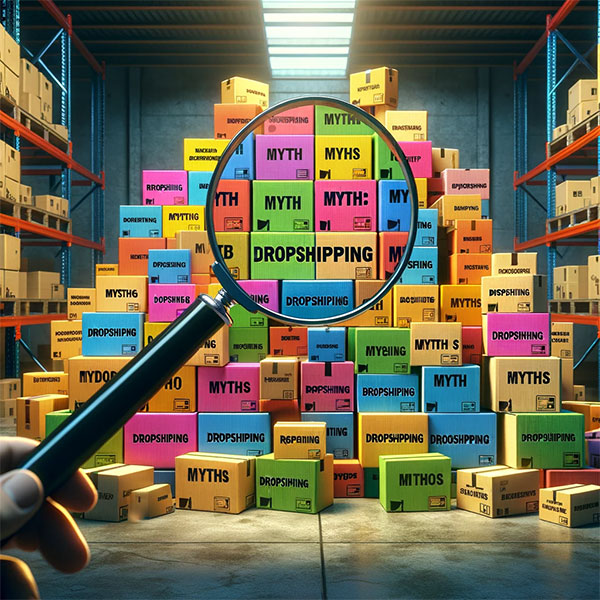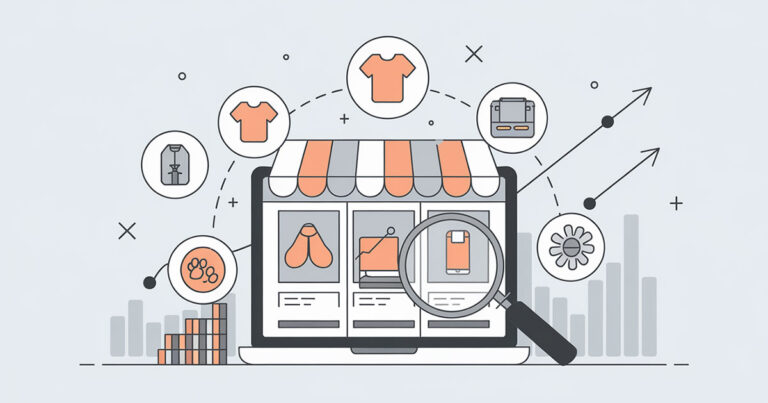The Top 20 Dropshipping Myths: Absolutely Busted!

Hey there! You’ve probably heard about dropshipping, right? It’s the buzzword in the e-commerce world that’s been doing the rounds for around 10 years now. It’s often portrayed as this super easy, get-rich-quick business model. But hey, let’s be real for a moment. As someone who’s dropshipping for quite some time, I’m here to tell you that there’s more to dropshipping than meets the eye.
Why am I writing this? Well, I’ve seen too many enthusiastic folks jump into the dropshipping ocean only to find themselves in choppy waters, all because they believed some of the myths floating around. That’s why I’m busting the top 20 dropshipping myths today. My aim? To set the record straight and give you a clear, no-nonsense picture of what dropshipping really entails.
So, whether you’re just curious, considering starting your own dropshipping business, or you’re already knee-deep in it, this piece is for you. I’m not just going to list these myths; I’m going to dissect them one at a time. Why? Because knowing the truth is your first step towards real success in the dropshipping world.
Let’s get these myths busted, shall we?
Common Dropshipping Myths or Misconceptions
Alright, let’s dive into the sea of myths that surround dropshipping. I’ll walk you through each one, giving you the lowdown on why they’re more fiction than fact. Ready? Here we go!

Myth 1: Instant Success
“Start dropshipping and watch the cash roll in overnight!” Sounds dreamy, right? But hold your horses. The truth is, like any business, dropshipping needs time, patience, and a solid strategy. Overnight success stories are rare, and there’s usually more to them than meets the eye.
Myth 2: No Financial Investment Needed
Here’s a biggie. Many think you can start dropshipping with zero dollars. Well, not exactly. Sure, you’re not stocking up on inventory, but remember, you’ve got marketing, website maintenance, and other fun stuff to pay for. It’s less investment, not no investment.
Myth 3: Zero Effort Required
“Oh, dropshipping is so easy!” – if I had a dollar for every time I heard that… Truth bomb: It requires effort. From managing supplier relationships to customer service and keeping your website spick and span, there’s plenty to do.
Myth 4: High Profit Margins
Yes, dropshipping can be profitable. But thinking you’ll consistently get huge margins is a stretch. Competition is fierce, and sometimes you have to play the price game, which can squeeze those margins.
Myth 5: Easy to Find Reliable Suppliers
Finding suppliers who are as reliable as a Swiss watch is not a walk in the park. It takes research and sometimes a bit of trial and error to find the right partners for your dropshipping journey.
Myth 6: Unlimited Product Selection
While it’s true you can sell a wide array of products, not everything is dropshipping-friendly. Think shipping costs, supplier reliability, and product quality. It’s about finding the right products, not just any products.
Myth 7: No Customer Service Needed
“I’ll just let the suppliers handle everything!” Hmm, not so fast. Customer service is your domain. Shipping issues, returns, customer queries – that’s all on you. And good customer service can make or break your business.
Myth 8: Simple to Scale
Scaling a dropshipping business isn’t just about adding more products. It’s about scaling customer service, handling more orders, and sometimes dealing with more supplier issues. It’s totally doable but requires a plan and some elbow grease.
Myth 9: It’s Only for Small Businesses
Dropshipping isn’t just a small player’s game. Even the big guns use dropshipping models to complement their businesses. It’s all about how you integrate it into your overall business strategy.
Myth 10: No Competition
“Oh, I’ll just find a niche product and be the only seller.” In theory, great. In practice, not so much. Dropshipping is a competitive arena, and chances are, someone else is selling something similar. But don’t let that discourage you – it’s all about finding your unique angle.
Myth 11: All Dropshipping is the Same
Think all dropshipping businesses are cut from the same cloth? Think again! There’s a variety – from selling niche products to leveraging big marketplaces. Each type has its own flavor and set of challenges.
Myth 12: No Need for a Business Plan
“Who needs a plan? I’ll just wing it!” – Famous last words. Even in dropshipping, a business plan is your roadmap to success. It helps you navigate the market, manage finances, and plot your growth strategy.
Myth 13: Dropshipping is Illegal or Unethical
Some folks think dropshipping is shady business. Not true! It’s as legal as any other business, but like anything else, it requires ethical practices and compliance with regulations. Doing things the right way is key.
Myth 14: Easy to Automate Completely
Automation is a dream, right? But in dropshipping, while you can automate some processes, you can’t set it on autopilot and forget it. You need to be involved, especially in decision-making and customer relationships.
Myth 15: No Risk of Inventory Issues
“Since I don’t handle inventory, I’m all clear!” Not so fast. You depend on suppliers for inventory, and sometimes, they run out or have delays. Staying on top of your inventory situation is crucial.
Myth 16: All About Selling on Major Platforms
Sure, platforms like Amazon and eBay are popular, but they’re not the be-all and end-all of dropshipping. Your own website or alternative platforms can also be gold mines. It’s about finding the right channel for your products.
Myth 17: No Need for Marketing
“If I build it, they will come” – not exactly a winning strategy in dropshipping. Marketing is what drives traffic to your store. Without it, you’re like a hidden treasure that no one knows about.
Myth 18: Dropshipping is a Short-Term Business Model
Some think dropshipping is just a fad. However, it’s a viable, long-term business model if approached correctly. It’s not just a quick splash; with the right strategy, it can be a lasting swim in the e-commerce ocean.
Myth 19: Product Quality is Not a Concern
This one’s tricky. You’re not producing the products, but their quality directly affects your reputation. Partnering with suppliers who provide quality products is crucial for your brand’s success and customer satisfaction.
Myth 20: No Legal Requirements
“Just because it’s online doesn’t mean it’s lawless!” Dropshipping, like any business, has its share of legalities – taxes, business licenses, consumer rights. Staying on top of these is crucial for running a legit operation.
The Reality of Dropshipping
So, we’ve busted some myths. Now, let’s talk about what dropshipping really involves. It’s not all doom and gloom, I promise! But it’s important to have a clear-eyed view of the landscape.

The Effort Involved
Dropshipping isn’t a set-it-and-forget-it kind of deal. It demands your attention and effort. You’ll be juggling supplier relations, customer service, and your online presence. Each of these areas requires time, effort, and a fair bit of learning.
Financial Considerations
Yes, you save on inventory costs. But remember, you need to invest in other areas. A good website, effective marketing, and perhaps even some software to streamline processes are all part of the financial equation.
The Importance of Supplier Relationships
Your suppliers are your lifeline. Building strong, reliable relationships with them is crucial. This means vetting them carefully, communicating regularly, and sometimes having a backup plan in case things go south.
Customer Service is Key
Never underestimate the power of good customer service. In the world of dropshipping, where you have less control over inventory and shipping, keeping your customers happy and informed can make a huge difference.
The Need for Continuous Learning
The e-commerce landscape is always changing, and so are the best practices in dropshipping. Staying up-to-date, adapting to new trends, and continuously learning about new tools and strategies is vital.
Ethical Practices
Running your business ethically is not just good karma; it’s good business. This means being transparent with your customers, respecting supplier agreements, and adhering to legal standards.
Marketing Matters
Your marketing strategy can make or break your dropshipping business. Understanding your audience, crafting compelling messages, and using the right channels to reach potential customers are all part of the game.
Building a Sustainable Dropshipping Business: Fresh Perspectives
Alright, we’ve talked about the ground realities of dropshipping. Now, let’s switch gears and explore some fresh perspectives and innovative strategies for building a sustainable dropshipping business.

Cultivate a Unique Brand Identity
Your brand is what sets you apart in the dropshipping world. Develop a unique brand identity that resonates with your target audience. This includes your brand’s voice, visual elements, and the overall message you want to convey.
Leverage Social Proof and User-Generated Content
In the digital age, social proof is gold. Encourage your customers to leave reviews, share photos, and tell their stories. User-generated content not only builds credibility but also creates a community around your brand.
Explore Cross-Selling and Upselling Opportunities
Maximize the value of each customer interaction. Implement strategies like cross-selling and upselling to increase your average order value. This could mean recommending related products or offering a discount on bundles.
Optimize Your Website for Conversion
Your website is your storefront. Make sure it’s optimized for a smooth user experience, quick load times, and mobile responsiveness. An easy-to-navigate, visually appealing website can significantly boost conversions.
Harness the Power of Email Marketing
Email marketing remains one of the most effective channels for customer retention and engagement. Use it to keep your customers informed about new products, special offers, and valuable content.
Focus on Sustainable Growth
Rather than chasing rapid expansion, focus on sustainable growth. This means making decisions that are financially sound, scalable, and in line with your long-term business goals.
Develop Strategic Partnerships
Consider partnering with complementary businesses or influencers in your niche. This can open up new marketing channels, extend your reach, and add value to your brand.

Stay Committed to Continuous Improvement
Regularly review your business performance, customer feedback, and market trends. Be open to making changes, whether it’s tweaking your marketing strategy, updating your product offerings, or enhancing your customer service.
Conclusion
And that’s a wrap on our deep dive into the world of dropshipping! We’ve busted myths, faced the realities, and explored strategies for sustainable growth. I hope this journey has been as enlightening for you as it has been for me.
Recap of Our Myth-Busting Adventure
We started by shattering those glossy myths about instant success, zero effort, and no investment. Then, we peeled back the layers to reveal the true nature of dropshipping – a business model that’s rewarding, but not without its challenges.
Embracing the Realities
Dropshipping isn’t a shortcut to overnight riches, nor is it a passive income paradise. It’s a legitimate business model that demands your time, effort, and strategic thinking. But don’t let that discourage you. With the right approach, it can be an incredibly fulfilling and profitable venture.
The Path Forward
If there’s one thing I want you to take away from all this, it’s that success in dropshipping comes from perseverance, adaptability, and a willingness to learn. It’s about building relationships, understanding your audience, and staying true to your brand.
Parting Words of Encouragement
So, whether you’re just starting out or looking to grow your existing dropshipping business, remember: the road might be bumpy, but the destination is worth it. Stay curious, stay committed, and most importantly, stay ethical in your business practices.
Thank you for joining me on this myth-busting journey. Here’s to your success in the dynamic world of dropshipping!
Resources
To support and enrich your understanding of various aspects of running a dropshipping business, I’ve compiled a list of resources from credible and authoritative sources. These URLs offer in-depth insights and practical advice on key topics like business planning, finance, influencer partnerships, automation, email marketing, and branding. Each of these areas plays a crucial role in the success of a dropshipping venture. Here are the resources:
- Business Planning:
- U.S. Small Business Administration (SBA) – Write Your Business Plan
- The SBA provides a thorough guide on how to write a business plan, an essential first step in establishing a dropshipping business.
- U.S. Small Business Administration (SBA) – Write Your Business Plan
- Business Finance:
- Investopedia – Understanding Small Business Financing
- Investopedia offers insights into the financial aspects crucial for running a small business, including funding options and financial management strategies.
- Investopedia – Understanding Small Business Financing
- Influencer Partnerships:
- Forbes – How To Build Effective Influencer Partnerships
- Forbes discusses strategies for creating successful influencer partnerships, a valuable marketing approach for dropshipping businesses.
- Forbes – How To Build Effective Influencer Partnerships
- Business Automation:
- Entrepreneur – How to Use Automation in Your Business for Efficiency
- Entrepreneur explores how automation can streamline various business processes, a key factor in scaling and managing a dropshipping business efficiently.
- Entrepreneur – How to Use Automation in Your Business for Efficiency
- Email Marketing:
- HubSpot – The Ultimate Guide to Email Marketing
- HubSpot provides a comprehensive guide on email marketing, an effective tool for engaging and retaining customers in a dropshipping business.
- HubSpot – The Ultimate Guide to Email Marketing
- Branding:
- Harvard Business Review – Branding in the Digital Age
- Harvard Business Review offers insights into branding strategies in the digital era, crucial for establishing a unique identity for your dropshipping business.
- Harvard Business Review – Branding in the Digital Age
These resources will help deepen your understanding and enhance your strategies for running a successful dropshipping business online.






